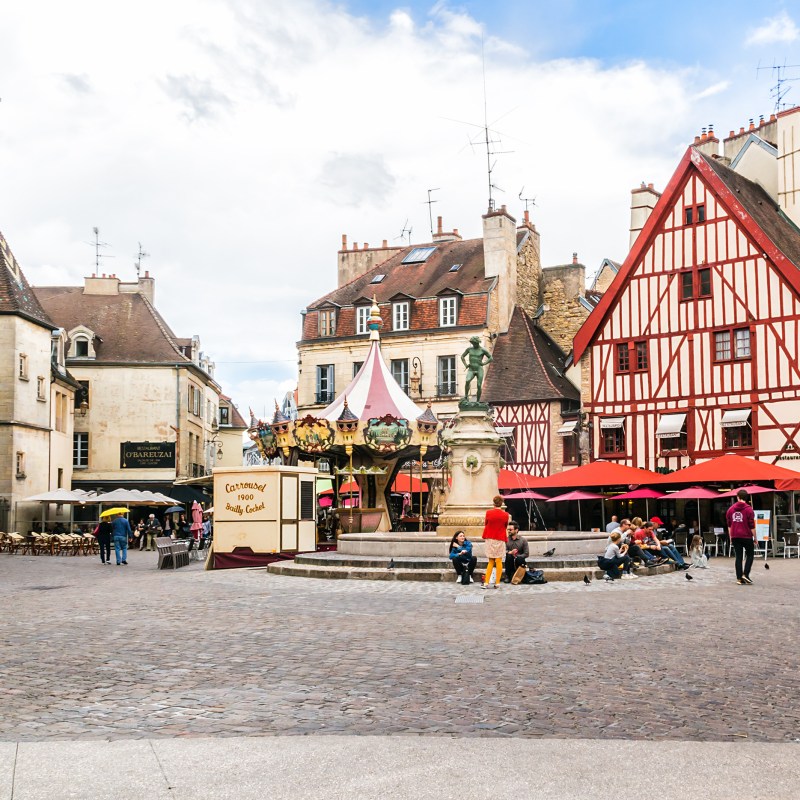
Dijon, the capital of the Cote-d’Or en Bourgogne-Franche-Comte region in France, once known to the Romans as Divio, is perfectly situated as a stop-over point on the road from Lyon to Paris. The small city of around 150,000 inhabitants (250,000 for the greater Dijon region) reflects its history with a lovely array of different styles of architecture all nestled together, making for a great atmosphere and very photogenic corners. The entire city center, with its crooked, old half-timbered buildings, is registered as a UNESCO World Heritage site.
Videos by TravelAwaits
Ask anybody, and they’ll have heard of Dijon mustard, Burgundy wine, boeuf bourguignon, Burgundy snails, and maybe even the French’s favorite Comte cheese, so the clues are there that this is a region focused on its food. Dijon itself has a lovely covered market designed by Gustave Eiffel who was born in the city, and which hosts the International Gastronomy Fair for two weeks each November. It is one of the top 10 food fairs in France. Consider the love of food and wine, the manifold architecture, and the long history, and you have a place that is well worth exploring.

Things To See And Do In Dijon
Visit The Palace Of The Dukes Of Burgundy
The Dukes of Burgundy ruled the Duchy of Burgundy, Bourgogne, between 1463 and 1577. And while the oldest parts of the palace date to the 14th century, the most obvious sections that stand proud today date from the 17th and 18th centuries. The adjacent 150-foot-tall Tower of Philippe Le Bon, whose 316-step spiral staircase you can climb up to enjoy the views over Dijon’s rooftops, and, on a good day, all the way to Mont Blanc, dates from the 15th century. A little tiring to climb, but so worth it. Today, the palace houses the Town Hall and the Fine Arts Museum (more on that below).
Follow The Trail Of The Owl
The owl, or chouette, is the symbol of Dijon, and you will find golden plaques on the ground that designate a self-guided walking tour, the map for which you can pick up at the Tourism Information Office right at the back of the Palace of the Dukes of Burgundy. The trail leads you past all the important sights of Dijon and is fun to follow. Most importantly, though, you must visit the 300-year-old stone-carved owl on the Eglise de Notre Dame (more on this below). Legend has it, if you rub it with your left hand and make a wish, it will come true. The superstition has sadly left the little owl looking a little worse for wear.

Count The Gargoyles On Notre Dame Church
This imposing church dates to the 13th century and stands on Rue de la Chouette, Owl Street. Three rows of gargoyles, each one different from the next, make it a stunning piece of architecture. Another distinction is the fabulous Jacquemart clock on top of the church. It was brought to Dijon by Duke Philip the Bold as a war souvenir in 1383. The word Jacquemart refers to the mechanized figure that rings the bell, and, according to folklore, the good citizens of Dijon thought the Jacquemart to be lonely, so, in the 17th century they gave him a wife called Jacqueline. In the 18th century, the couple “had” a son Jacquelinet and in the 19th century, a daughter called Jacquelinette. Today, the happy family chimes the bell every 15 minutes.
Did you count the gargoyles? Spoiler alert: There are 51.

Hotel De Vogue
One of Dijon’s grandest buildings, next to the Notre Dame church, is the Hotel de Vogue.
It was built in 1614, as the date on the old fireplace states. Built for an advisor to and magistrate in the Burgundy parliament, the building exhibits an eclectic mix of styles, mostly Italianate, with a Renaissance portico, all set around a lovely courtyard with a well. Owned by the City of Dijon, it houses the city’s Department of Human Resources, but you can slip in through the arch and look around the courtyard.

Enjoy The Fine Arts Museum
Located inside the former palace, the Fine Arts Museum is a treasure trove of antiquities, medieval art, local Burgundy art, sculpture, and much more, right up to the 20th century. Set in the splendid surroundings of the palace, it is just as much about the art as it is the location.

Drive The Route Des Grands Crus
The rolling hills of the surrounding wine region are studded with picturesque villages (a fair number of them listed as Plus Beaux Villages de France, a designation that recognizes, and literally means, the prettiest villages of France) along the Route des Grands Crus, the wine route, plus a couple more World Heritage sites, including beautiful Vezelay and the ancient Fontenay Abbey dating back to the 1100s. And then there is Beaune, a rival in the French mustard scene.
Learn About Mustard
Mustard seeds date back to Roman times as a flavoring for food, but mustard as a sauce was, reportedly, invented right here in Dijon. And where better, considering mustard is made from mustard seeds and crushed green grapes? To learn all about the history of mustard, visit the beautiful Musee de la Vie Bourguignonne (Museum of Burgundian Life), set in an old convent. And to taste the amazing number of varieties, look no further than the Moutarderie Edmond Fallot, just across from the lucky owl on Rue de la Chouette.

Best Places To Eat In Dijon
As I mentioned in the introduction, food and wine are of huge importance in Dijon, and because of that, you don’t need to search out fancy, starred restaurants or pay a small fortune for a good meal. The people of Dijon are proud of their local dishes, such as boeuf bourguignon, a hearty beef stew; coq au vin, chicken in a red wine sauce; and escargots, snails in a pungent garlic herb butter. Add some mustard and a glass of the local wine, and you are good to go.
Les Halles Market is not only a lovely building and a bustling market full of local atmosphere but also has food stalls that allow you to sample all there is, and, if you are staying in accommodations with a kitchen, shop for a little something for later.
Le Kent Brasserie sounds a lot grander than it looks. This is a simple restaurant right by the market and is frequented by locals. No tablecloths, nothing fancy at all — even a TV on in the background. But the daily menu reflects what came in fresh from the market that morning and is prepared in a no-fuss manner. And it is not only very good but also very cheap.
BHV just across from the Grand Palace of the Dukes of Burgundy lies this pretty bar-restaurant. Very chic inside without being overbearing, and with tables out on the huge square, this place is perfect for sundowner cocktails with some tapas on the side. You will probably find that you will stay on for dinner, as the atmosphere is great, the setting lovely, and the food good.
On a little square overlooking the theatre and next to a church that doubles as a library, Brasserie La Comedie is a good spot for a breakfast of either warm croissants and baguette or a simple omelet with a side of coffee and fresh orange juice. A nice old-fashioned restaurant, traditional inside, and with a more bustling terrace out front, the cafe is also great for evening drinks and people watching.
Where To Shop In Dijon
Being a small town but the capital of the region, Dijon offers very accessible and easily walkable shopping of good quality and variety. From a large Galeries Lafayette department store to quaint little individual boutiques, Dijon shopping might not be on the scale of larger cities, but that makes it even more enjoyable.
For general shopping, walk up and down Rue de la Liberte and the side streets of Rue des Forges and Rue Bossuet. On Rue Bossuet, don’t miss Mulot et Petitjean, a gorgeously old-fashioned shop selling gingerbreads.
And do stroll along Rue Verrerie, which is full of shops selling antiques and home decor plus small art galleries.

Best Places To Stay In Dijon
Reflecting the long history and varied architecture, you get a number of accommodation options in Dijon, and also something for every budget.
Grand Hotel La Cloche is a luxury Sofitel chain property. Set inside a grand old building, the interior is modern with a fine dining restaurant and a chic bar, and you can expect all the modern conveniences.
Maison Philippe Le Bon occupies three heritage buildings set around a Gothic courtyard and oozes old-world charm. Right in the city center, it also has a beautiful restaurant.
Odalys Apart’hotel Les Cordeliers offers apartments equipped with kitchenettes for more space and a chance to have the odd meal in your room. Set in an old monastery, the accommodation is simple but a good value.
Pro Tip
While Dijon is a great town that will keep you busy for an entire weekend, it would be a real shame not to see the gorgeous countryside and wine region outside the city limits. Explore further by either renting a car or bicycles, or going on an organized tour of the area.
Planning a French getaway? Don’t miss
